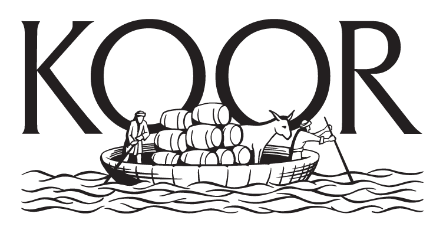Wine is the only form of art that can be tasted. Just take a sip and get in touch with the history, imbibe the essence of a country's culture and feel the soul of its creator.
Wine is a unique bridge between the past and future transferring decoded information in a sip: a wine connoisseur should only take that, decode the mystery and he will touch the history and culture of a whole nation.
Koor is a vivid example of a guiding star into the depths of the ocean of the history. A sip of white Koor will take you far away to Ancient Babylon, and the white Koor will help you find yourself on the bank of the powerful Euphrates River – the cradle of the first thriving civilizations and later great empires.
Wine reaches authenticity if treated with care, and the genuine care lies in details – starting from a small vine in a faraway village up to participation in the famous Wine Paris Expo.
Koor takes care for each bottle, which is created with heart and soul, and it can be tasted even in a sip of Koor.
The winery strives to make Armenian wines not a luxury product or an item to show off with but an inseparable part of the everyday life and culture.
The nation having a 6000-year-old history cannot live without vine and wine.
Koor winery is a true example of a link between the present and past. The very wine, design and label together tell about the history passed on to the young generation while uncorking every new bottle.
The whole philosophy of Koor is based on preserving the local traditions and historical legacy of Armenians as a winemaking nation. At the same time, the aim is to breathe new life into it and contribute to the era of the Renaissance of the Armenian winemaking.
The history of Koor dates back to 2014, in the period of reviving love for wine in Armenia and love for the country itself. Indeed, one should really love the region to feel like spending the rest of his life here with the dear ones, drink the favorite wine by the crackling fire in the fireplace.
Initially, the wine was produced as a hobby, however, as the dedication grew, it became a major project with a great future.
''A journey of thousands of years'', this is the slogan of the winery, which indeed conveys the historical basis embodied by the very wines of Koor.
In the 5th century BC, Ancient Greek historian Herodotus created his magnum opus – the first of its kind historical piece in the European literature “History” (or “The Muses”) depicting the Greco-Persian wars. At the same time, the great historian created a real encyclopedia containing information on geography, ethnography, natural sciences and history as well as literature of the great empires and ancient civilizations.
In Chapter 194 of the first book, “Clio”, Herodotus thoroughly depicts the city of Babylon with its culture, history as well as the lifestyle and routine of the peoples living there. It is in this chapter that the historian tells with wonder how Armenian merchants on small leather-covered boats loaded with straws transport their wines along the Euphrates to sell in Babylon. Wine and straw are shortly sold and the skins are loaded onto the donkeys and brought down the river back to Armenia.
These boats were historically called “Koor”, and the logo of Koor wines features this theme – a small boat loaded with wine and people going down the Euphrates to magnificent Babylon.
Vayots Dzor region was selected when it came to purchasing vineyards for Koor. The region is closely linked to the history of the Armenian people like no other region at the same time boasting a unique terroir for vine cultivation.
Koor produces wine from three technical varieties – Areni, Khndoghni for the reds and Voskehat for the whites.
The winery purchased overall 14.5hectares of vineyards in the historical village of Aghavnadzor in 2017. The red variety is cultivated here; the average age of the vines reaches up to 20 years.
In 2020, 10 more hectares were purchased here for cultivation of a white autochthonous variety, Voskehat. Almost all of the Voskehat grapes are bought from local farmers; however, the cultivation is controlled and the grape quality is strictly monitored.
Hrach Martirosyan is the viticulturist of Koor. He graduated from the National Agrarian University in 2009 and has been working with Koor for over 7 years.
Owing to favorable natural and climatic conditions, vineyards are not covered for winter, and the vines grow on their own roots.
Due to the distinctive dryness and prevalence of volcanic soils, the vineyards are irrigated through central irrigation system 4 times, the last one being in August which is a favorable option for the local terroir.
In the vineyards, the distance between the vines is 1.5m distance and the rows are 2.2m away from each other. The vine plants are formed with a classical method, with the use of Guyot system.
On average, the Areni vineyards are located at 1380m above the sea level. In June, green harvest is practiced, and the harvest per 1ha reaches up to 7-8tons.
Voskehat harvest takes places in October, while in case of Areni quite late harvesting is practiced sometimes lasting until December. The Areni grape is intentionally kept on the vine till the upper crown starts drying off – this is when the bunch reaches the highest peak of ripening.
A separate small vineyard called Aurora in Aghavnadzor is the pride of the winery. In 2018, 300 vines of Areni were consecrated in the ancient Armenian Khor Virap Monastery. After the religious ritual, each participant of the Aurora Humanitarian Initiative planted a vine here. In this case, it embodies the value of a man’s life, and the idea that the planet cannot exist without humanism and love.
The first vine in the vineyard was planted by the winner of the award.
This vineyard is cultivated with single-arm Cordon training system, and the distance between the rows is kept up to 0.75m and the rows are 2.2m away from each other.
One of the key principles of growth is constant movement forward without stopping at the achieved results, as well as the aspiration to strive for the best. Sticking to this principle, every new vintage of Koor wines is better than the previous one.
The winery mainly outsources the production to Wine Works.
Arman Manukyan, a talented professional, is the chief enologist. He studied at Montpellier and worked in Bordeaux for a long time. All the production processes are organized and controlled by him based on the set algorithm and formula.
Modern equipment is used for the production – vibratables and pneumatic presses “Bucher Vaslin” (France), European stainless steel temperature control tanks, French “Gyropalette” machines.
The winery owns classical 225l medium toast barriques made of Caucasian oak with up to 6-year operation period.
3 types of bottles produced by “Saverglass” (France) are “Diam Bouchage’s” natural whole corks Diam-5 and Diam-10 are used for the wines.
Koor produces 2 lines of wines – Koor Classic (Red and White) and Koor Reserve (Red and White). Koor Classic is produced in stainless steel tanks. 2014 was the first vintage and it was released in 2015.
Koor White Reserve is a varietal wine made from Voskehat. It is aged for 12 months in Caucasian oak barrels. 2015 was the first vintage of the wine.
Koor Red Reserve is a blend of 2 red varieties – Areni and Khndoghni with 50%/50% or 60%/40% mixing depending on the level of tannins of the Areni in a particular year. The wine is kept in a barrel for 18-24 months. The barrels for this wine are procured by famous “Seguin Moreau” (France), and 2014 was the first vintage of the wine.
Before being released to the market, Koor wines “live” in the cellars for at least 3 months after the bottling.
Despite being an amateur boutique project with 15 000 bottles of yearly production, the winery for a short time has managed to yield significant results. Today, it produces 15 000 bottles a year - 50% of whites and 50% of reds. Overall 10 000 bottles a year are produced for the Koor Reserve line.
To promote the brand, Koor is planning to build winery premises with innovative production solutions which will later become a tourist hub for the winemaking region of Vayots Dzor.
Planted in 2018, Aurora vineyard is one small but very touching project by the company. At the dawn, all the participants of the international Aurora Humanitarian Award were gifted with personalized jugs with 350 Areni vines in the ancient Khor Virap Monastery on the slope of the biblical Mount Ararat. Then all the stocks were planted in the new vineyard with the same name.
The main goal was to later produce a symbolic wine from this small vineyard to stand for unity of all the peoples of the world and goodness on the planet.
The world should recognize Armenia and Armenian wines only through local grape varieties. The winery strives to experiment with Armenian autochthonous and selection varieties; all the achievements of the winery have been reached solely with the local grapes.
Armenian consumers are also a key target for the sales strategy – 70% of the wines is produced for the local market, and only 30% is exported.
Koor wines are exported to Russia, the USA, Canada, Sweden, Switzerland, Belgium, the United Kingdom, Czech Republic, France and Japan.


 History
History
 Vineyards
Vineyards
 Production
Production
 Tourism
Tourism
 Export
Export

